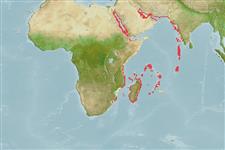>
Gobiiformes (Gobies) >
Gobiidae (Gobies) > Gobiinae
Etymology: Trimma: Greek, trimma, -atos = something crushed (Ref. 45335).
Eponymy: Heinrich Mendelssohn (1910–2002) of Tel Aviv University studied zoology and medicine at the University of Berlin (1928–1933). [...] (Ref. 128868), visit book page.
Environment: milieu / climate zone / depth range / distribution range
Ökologie
seewasser riff-verbunden; tiefenbereich 2 - 20 m (Ref. 57688). Tropical
Western Indian Ocean: Gulf of Aqaba to the islands of the western Indian Ocean as far south as Tulear, Madagascar; east to the Cargados Carajos shoals north of Mauritius
Size / Gewicht / Alter
Maturity: Lm ? range ? - ? cm
Max length : 4.0 cm TL Männchen/unbestimmt; (Ref. 11344)
This species is distinguished by having the following characters: with a frontal ridge that slopes variably (steeply, and with a ridge, to gradually, without a ridge) into the interorbital trench; postorbital trenches may be steep or shallow sided; posterior nasal opening adnate to eye; second spine of first dorsal fin occasionally elongate, third spine is not; eight or more elements in the second dorsal; fifth pelvic fin ray branched multiple times dichotomously, appearing bushy; 18 or more pectoral rays; scales on head; body color brown-red with five diffuse white vertical bars, between mid-peduncle to just anterior to origin of first dorsal; facial pattern with two white bars under orbit,
and one irregular white bar over vertical limb of the preopercle; a pair of thin fleshy lappets, half a pupil width apart, a quarter pupil width behind the frontal ridge, on either side of dorsal midline of the nape; epibranch of the first gill arch lacks gill rakers (Ref.57688).
Collected over coral reef flats rising above the rubble-sandy bottom (Ref. 57688).
Life cycle and mating behavior
Geschlechtsreife | Fortpflanzung | Ablaichen | Eier | Fecundity | Larven
Winterbottom, R., 1995. Red Sea gobiid fishes of the genus Trimma, with the description of two new species. Rev. Fr. Aquariol. 22(3-4):93-98. (Ref. 13694)
IUCN Rote Liste Status (Ref. 130435: Version 2024-2)
Bedrohung für Menschen
Harmless
Nutzung durch Menschen
Fischereien: nicht kommerziell
Tools
Zusatzinformationen
Download XML
Internet Quellen
Estimates based on models
Preferred temperature (Ref.
123201): 24.7 - 29.1, mean 27.5 °C (based on 537 cells).
Phylogenetic diversity index (Ref.
82804): PD
50 = 0.5000 [Uniqueness, from 0.5 = low to 2.0 = high].
Bayesian length-weight: a=0.00759 (0.00418 - 0.01376), b=2.93 (2.77 - 3.09), in cm total length, based on LWR estimates for this species & (Sub)family-body (Ref.
93245).
Widerstandsfähigkeit (Ref.
120179): hoch, Verdopplung der Population dauert weniger als 15 Monate. (Preliminary K or Fecundity.).
Fishing Vulnerability (Ref.
59153): Low vulnerability (10 of 100).
Nutrients (Ref.
124155): Calcium = 260 [125, 651] mg/100g; Iron = 1.32 [0.64, 2.58] mg/100g; Protein = 18.3 [16.3, 20.0] %; Omega3 = 0.159 [0.063, 0.354] g/100g; Selenium = 25 [10, 56] μg/100g; VitaminA = 124 [32, 468] μg/100g; Zinc = 3.23 [1.98, 5.00] mg/100g (wet weight);
